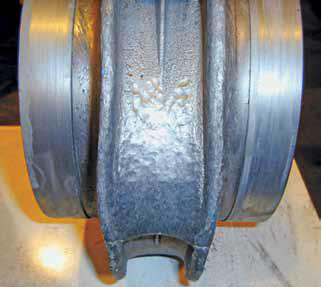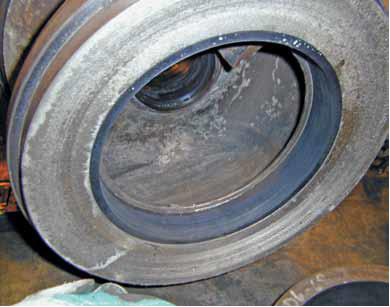Pumps & Systems, May 2011
Part One of this series addressed potential reliability improvements from using nonmetallic wear rings with reduced clearance. Part Two evaluated the efficiency gains from reduced clearance. In this final look at pump wear rings, the safety impact of nonmetallic rings with reduced clearances is examined.
Whether a plant uses metal wear rings or nonmetallic wear rings, it has a responsibility to have the necessary safeguards in place to ensure safe operation. This obligation does not go away with nonmetallic wear rings. However, under certain circumstances, nonmetallic wear rings can mitigate the damage from off-design events.
Pump Seizure
Wear rings are the primary interface between rotating and stationary parts in the pump. Under normal operating conditions, little contact occurs at the wear rings. However, hard contact can occur at the wear rings when the pump experiences off-design conditions such as dry running, zero-flow operation or an external event—such as a failed bearing. These circumstances can expose the difference between metal and nonmetallic wear rings. Metal With metal wear rings, an inherent risk of seizure exists—high-speed contact between rotating and stationary parts, welding the parts together. Seizure is an uncommon failure mode but is highly undesirable. When a pump seizes, the rotor often stops abruptly. This can cause broken shafts, failed seals, broken couplings, release of product to atmosphere and all the other negative consequences that can stem from product release. To avoid seizure with metal wear rings, API610 recommends minimum clearances and “a difference in Brinell harness number of at least 50 unless both [wear] rings have a Brinell hardness number of at least 400.” These guidelines reduce but do not eliminate the risk of seizure.
Nonmetallic
With the use of nonmetallic wear rings, the ordinary metal-to-metal interfaces within the pump can be eliminated, and clearances can be reduced. Extensive industry experience has shown that nonmetallic materials do not seize in the same manner as metal parts. Therefore, a rapid stopping of the pump rotor is highly unlikely.
Example:
Consider the impeller shown in Figure 1 (below).
 |
| Figure 1. Impeller after incident |
A foreign metal object entered the process stream and lodged itself inside the impeller. The event created very high vibrations and extreme impact loads on the wear rings. Fortunately, this pump was fitted with stationary composite wear rings as shown in Figure 2 (below).
 |
| Figure 2. Composite material case wear ring after incident |
The operators heard the noise, shut the pump down and put the spare pump into service without incident. The pump did not seize. No damage to the major pump components occurred except for the impeller, and hazardous product was not released to the atmosphere.
Wear Ring Clearance
With metal wear rings, a common practice when faced with pump seizure is to increase the wear ring clearance. As discussed in the first two parts of this series, increased clearance reduces the reliability and efficiency of the pump. Increased clearance can also lead to “excessive vibration, driver or pump bearing failure, shaft breakage, driver overloading and possible total pump destruction.” (Bloch & Geitner, p. 35) Conversely, with reduced wear ring clearance, as discussed in Part One of this series, the pump rotor will benefit from additional stiffness and damping, which can reduce vibration; shaft deflection; and the related loads on the critical pump components such as the bearings, drivers and seals.
Material Selection
When selecting a nonmetallic wear ring material, users should consider what happens to the wear rings during off-design operation. Heavily loaded contact between rotating and stationary parts is likely. As in the example above, the rings could experience impact loading. If the pump runs dry, heat will be generated, and potentially, thermal shock may occur when the liquid flow is restored. To withstand these forces, some of the material properties to consider are wear resistance, impact resistance, thermal shock resistance and the coefficient of thermal expansion. No material is indestructible, but with consideration of the above factors, nonmetallic wear rings should remain intact during all but the most extreme off-design events.
Conclusions
Centrifugal pumps are generally safe. However, off-design operation can sometimes lead to extensive damage due to seizure at the metal wear rings. With metal wear rings, the traditional solution has been to increase the clearance at the expense of reliability, efficiency and rotor stability. Nonmetallic materials allow the user to eliminate the metal-to-metal interfaces within the pump and reduce the clearance. This upgrade improves reliability and efficiency, while minimizing the risk of seizure and mitigating damage to the pump during off-design events. Conversely, if a plant avoids one major event through the use of nonmetallic wear rings, the savings from that one event can easily justify the upgrade of hundreds of pumps.
References:
American Petroleum Institute, API Standard 610 11th Edition, (ISO13709), Centrifugal Pumps for Petroleum, Petrochemical and Natural Gas Industries, September 2010.
Bloch, H.P. & Budris, A.R., Pump Users Handbook: Life Extension, The Fairmont Press, 2003.
Bloch, H.P. & Geitner, F.K., Practical Machinery Management for Process Plants, Volume 4, Major Process Equipment Maintenance and Repair, Gulf Publishing, Houston, Texas, 1985.
Henshaw, T., “Effect of Internal Clearances on NPSHR,” Pumps and Systems, July 2009.
Mancini, M., “Increasing Pump Reliability and Life (Part 2)” Pumps and Systems, January 2009.
Marscher, W.D., “An End User's Guide to Pump Rotordynamics,” Proceedings of the 23rd International Pump Users Symposium, Turbomachinery Laboratory, Texas A&M University, College Station, Texas, pp. 69 – 83, 2007.
Pumps & Systems, May 2011

